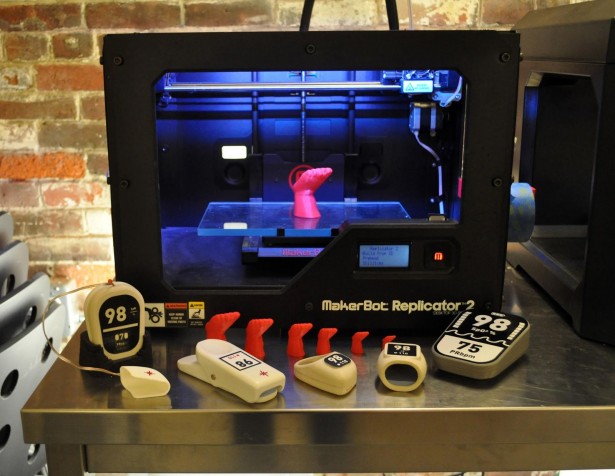Non-Profit Design that Matters Prints 3D Models that Communicate Across Cultures
Design that Matters (DtM) is a non-profit based in Salem, MA that uses the power of design to find the best opportunities for technology to have a massive impact serving the poor in developing countries. You may have already learned about us from the SOLIDWORKS blog or November Webinar. We use SOLIDWORKS to visualize medical device concepts from the very first day we launch a program. SOLIDWORKS enables us to easily make prototypes of our ideas using our Makerbot 3D Printer. To kick off our Pelican project, we used rough pulse oximiter models to collect direct feedback from community health workers, nurses, doctors, and parents in Haiti, hosted by Partners in Health and the St Boniface Haiti Foundation.
Pulse oximeters measure blood oxygen saturation by shining a light through a newborn’s foot to a detector on the other side. Design that Matters is designing a pulse oximeter to enable community health workers, nurses, and doctors to identify newborns with pneumonia, enabling them to get respiratory treatment and antibiotics.
During a visit to Boucan Carré Health Center, we spoke with Triage Nurse, Lainé. Her job is to take the vital signs on all new patients to determine who should see them next. She used our newborn doll to try the 3D-printed Pelican concept developed by our MIT and Rhode Island School of Design Student team. We noticed she was pinching the jaws shut, even though the jaws of the model spring shut on their own. She said she wanted to ensure she would get a good signal from the device, so she felt the sensor needed to put more pressure on the foot. This is invaluable early feedback that we can integrate into future models, coming directly from a person who works with newborns day in and day out.
During our visit in Haiti, we were lucky to be hosted by Dr. Jack Long and Dr. Delight Wing; pediatricians who spend half the year working in Haiti with Partners in Health, and the other half in Vermont. Both pediatricians, as well as nearly every local nurse and doctor, loved our shoe pulse oximiter concept. Dr. Long commented, “The shoe is particularly great because you can put it on the baby and then let the baby calm down by leaving it alone. Babies don’t like to be restricted, so it can be hard to take a reading while holding the baby’s foot the entire time.” Without a physical model, we may never have stumbled on this information which will be critical to the end product development.
Even more than descriptions, sketches, or renderings, we find tangible models prompt people to think through all the use steps. Seeing our models, nurses and doctors in Haiti immediately asked, “where is the power source?” At L’Hôpital Sainte-Thérèse de Hinche, Nurse Bien-Aime Iphonise revealed finding replacement coin cell batteries for their electronic thermometers is nearly impossible. We also saw many examples of equipment recharging through wall outlets, which affords another option, but we heard stories of rechargeable batteries quickly failing due to power spikes. At Boucan Carré Health Center, Dr. Jean Louis Judson indicated we could, “use standard size disposable batteries because we know where to buy those and we already do that. It is relatively expensive to buy batteries, but we can find them easily.”
In kicking off the Pelican pulse oximeter project, we made our earliest ideas tangible by sketching in SOLIDWORKS and then building models with our Makerbot 3D printer. The ability to move so quickly from thought to from completely revolutionizes Design that Matters’ process designing for people with different customs and cultures. We can now design a better product faster to save more lives.








